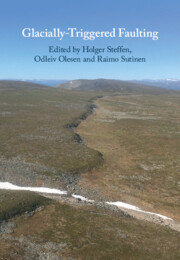Book contents
- Glacially-Triggered Faulting
- Glacially-Triggered Faulting
- Copyright page
- Contents
- Figures
- Tables
- Contributors
- Preface
- Part I Introduction
- 1 Glacially Triggered Faulting
- 2 Geomechanics of Glacially Triggered Faulting
- Part II Methods and Techniques for Fault Identification and Dating
- Part III Glacially Triggered Faulting in the Fennoscandian Shield
- Part IV Glacially Triggered Faulting at the Edge and in the Periphery of the Fennoscandian Shield
- Part V Glacially Triggered Faulting Outside Europe
- Part VI Modelling of Glacially Induced Faults and Stress
- Part VII Outlook
- Index
- References
1 - Glacially Triggered Faulting
A Historical Overview and Recent Developments
from Part I - Introduction
Published online by Cambridge University Press: 02 December 2021
- Glacially-Triggered Faulting
- Glacially-Triggered Faulting
- Copyright page
- Contents
- Figures
- Tables
- Contributors
- Preface
- Part I Introduction
- 1 Glacially Triggered Faulting
- 2 Geomechanics of Glacially Triggered Faulting
- Part II Methods and Techniques for Fault Identification and Dating
- Part III Glacially Triggered Faulting in the Fennoscandian Shield
- Part IV Glacially Triggered Faulting at the Edge and in the Periphery of the Fennoscandian Shield
- Part V Glacially Triggered Faulting Outside Europe
- Part VI Modelling of Glacially Induced Faults and Stress
- Part VII Outlook
- Index
- References
Summary
Glacially triggered faulting, also called glacially induced faulting or postglacial faulting, describes fault movement caused by a combination of tectonic and glacially induced isostatic stresses. Stresses induced by the advance and retreat of an ice sheet are thought to be released during or after ice melting and reactivate pre-existing faults. The most impressive fault scarps that witness such activity, are found in Northern Europe. It was assumed these features are unique. This view has changed recently as new faults were discovered – even outside the former glaciated area – and fault activity dating showed several phases of reactivation thousands of years after deglaciation ended. This book summarizes the research until the very recent findings. It reviews the theoretic aspects, i.e. the knowledge to understand the presence of glacially induced fault structures, followed by an overview of geological, geophysical, geodetic and geomorphological investigations methods, a summary of all known glacially induced faults worldwide and an outline for modelling of these stresses and faults.
Keywords
- Type
- Chapter
- Information
- Glacially-Triggered Faulting , pp. 3 - 19Publisher: Cambridge University PressPrint publication year: 2021
References
- 1
- Cited by



